Worldsfortweensteens
Download as PPTX, PDF0 likes229 views
This document discusses virtual worlds for kids, teens, and tweens. It lists several popular virtual worlds including Whyville, Webkinz, Teen Second Life, Doll Palace, Furcadia, World of Warcraft, and Club Penguin. It distinguishes between virtual worlds and games, noting that virtual worlds are persistent, multiuser environments that mimic real-world activities. The document also notes that Gartner Research predicts virtual world usage will increase significantly by 2011. It argues that libraries should be involved in virtual worlds because patrons are using them, they are growing educational platforms, and librarians can serve as guides within these worlds.
1 of 7
Download to read offline

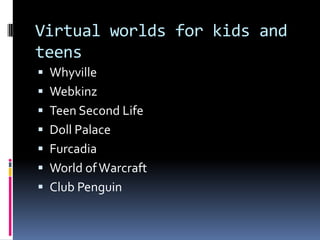

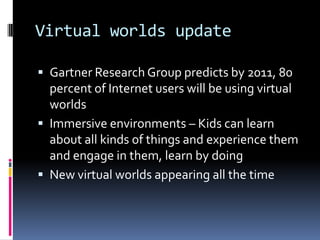
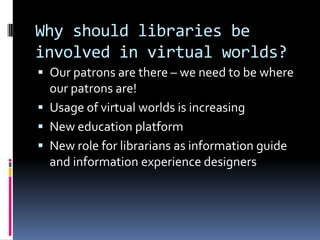
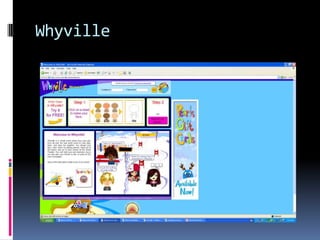
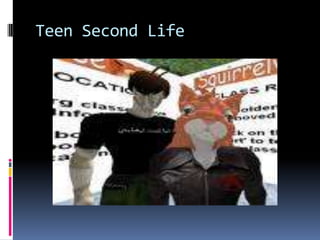
More Related Content
Viewers also liked (13)
PPT
A Second Life for the archivist: what do we have to look for in virtual worlds?Christian van der Ven╠²
A Second Life for the archivist: what do we have to look for in virtual worlds?Christian van der Ven
╠²
Similar to Worldsfortweensteens (20)
PDF
Francesco D'Orazio - Everything you know about virtual worlds is WRONG - Meta...Francesco D'Orazio╠²
Francesco D'Orazio - Everything you know about virtual worlds is WRONG - Meta...Francesco D'Orazio
╠²
Ad
Recently uploaded (20)
PPTX
MARTSIA: A Tool for Confidential Data Exchange via Public Blockchain - Poster...Michele Kryston╠²
PPTX
Mastering Authorization: Integrating Authentication and Authorization Data in...Hitachi, Ltd. OSS Solution Center.╠²
PDF
ÔÇ£A Re-imagination of Embedded Vision System Design,ÔÇØ a Presentation from Imag...Edge AI and Vision Alliance╠²
PDF
Bitkom eIDAS Summit | European Business Wallet: Use Cases, Macroeconomics, an...Carsten Stoecker╠²
Mastering Authorization: Integrating Authentication and Authorization Data in...Hitachi, Ltd. OSS Solution Center.
╠²
ÔÇ£A Re-imagination of Embedded Vision System Design,ÔÇØ a Presentation from Imag...Edge AI and Vision Alliance
╠²
Ad